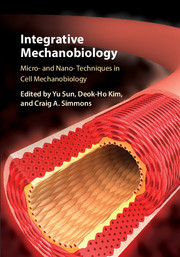Part I - Micro-nano techniques in cell mechanobiology
Published online by Cambridge University Press: 05 November 2015
Summary
Live cells can sense the mechanical characteristics of the microenvironment and translate the mechanical cues to intracellular biochemical signals in physiology and disease. To investigate intracellular signaling transduction during mechanosensing, nanotechnologies, and FRET live-cell imaging technologies have been developed to visualize the output signals in real time, such as intracellular molecular activity. Meanwhile, micropatterned technologies have been applied to modulate the physical and mechanical environment surrounding the cell to fine-tune the input signals in cellular mechanosensing. These advanced technologies can join forces and shed new light into the molecular networks that control mechanotransduction in normal conditions and disease.
- Type
- Chapter
- Information
- Integrative MechanobiologyMicro- and Nano- Techniques in Cell Mechanobiology, pp. 1 - 202Publisher: Cambridge University PressPrint publication year: 2015



